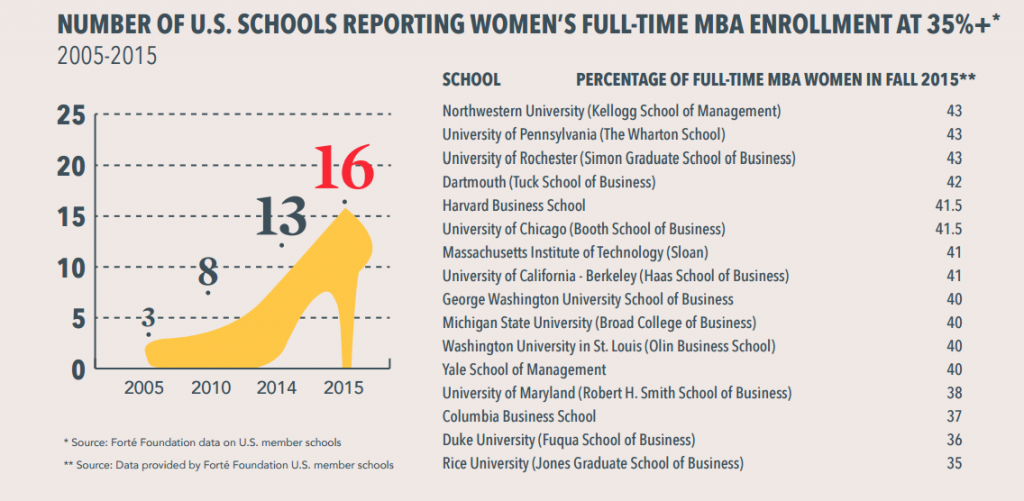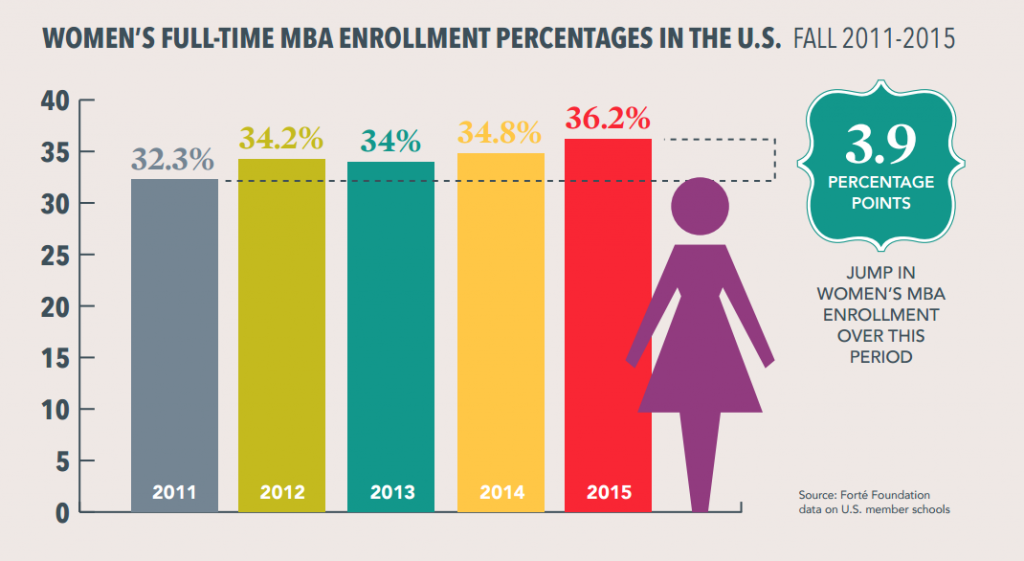Women make up at least 40 percent of the MBA class at 12 leading U.S. business schools this year, compared to just five last year, according to new data released today by the Forté Foundation, a nonprofit consortium of business schools and companies working to increase opportunities for women in business.
“In 2011, less than a third of MBA students were women. Today we’re inching closer to 40 percent in the United States and working to close the gap significantly in another five years,” says Forté Executive Director Elissa Sangster. “Every percentage point gain is not only hard earned, but something to celebrate, and should go a long way in building the senior leadership pipeline at companies and on boards,” she continues.
Among the U.S. schools leading the charge to increase female MBA enrollment are Dartmouth’s Tuck School of Business, Harvard Business School, MIT Sloan School of Management, Northwestern’s Kellogg School of Management, UC Berkeley’s Haas School of Business, the University of Chicago Booth School, the University of Pennsylvania’s Wharton School and the Yale School of Management, all of which topped 40 percent this year. Sixteen Forté U.S. member schools this year have at least 35 percent female enrollment, up from just three a decade ago.

Forté was launched in 2001 to address the then-stark underrepresentation of women in top business schools as compared to medical or law schools. Today, it has grown to 46 member schools in the United States, Canada and Europe and spearheads multiple initiatives aimed at closing the gender gap as it relates to pursuing an MBA and careers in business.
Among the organization’s many initiatives is the Forté Fellows program, through which exceptional female MBA students are awarded scholarships by participating member schools to offset the cost of business school. These scholarships have grown from 33 in 2003 to more than 800 for the incoming class of 2015, totaling more than $85 million in aid to date.
It also hosts two annual conferences, the Forté MBA Women’s Leadership Conference, which draws together hundreds of women MBAs and top companies, and the Forté College to Business Leadership Conference, designed to introduce undergraduate freshmen and sophomore women to business-related summer internships and entry-level jobs.
Sangster credits the Forté Forums, one of the organization’s longest-running programs, for perhaps having the greatest impact on helping increase female MBA enrollment. These free events, held each fall in cities across the United States, Canada and the United Kingdom, introduce talented young women to business school representatives, MBA alumnae and one another to raise awareness of the MBA degree and what it offers.
“We have had such amazing support from our business school partners in promoting it and hitting up their alumni ranks to share their inspirational stories,” she tells Clear Admit. “It’s clear when women are leaving these forums that they have had a life-changing event, not only because of the people they have gotten to meet but also because they have realized they are not alone—that there are so many other women out there just like them,” she says. Every year Forté reaches between five and six thousand women about the MBA through its marketing around these events. “That has pretty strong implications for changing the tide, and we are seeing increases in audience every year we have done them,” she says.
Forté Targets Multiple Leaks in the MBA Pipeline
More recent initiatives launched by Forté have also worked toward building the female MBA and business leadership pipelines. Launched this fall, a “Rising Star” pilot initiative debuted on 10 college campuses, designed to better inform undergraduate women about career opportunities in business. Another program, MBALaunch, helps guide prospective female MBA applicants through the competitive application process with 10 months of webinars, GMAT prep, one-on-one advising and in-person events.
“It’s not a leaky pipeline because there is one hole,” says Sangster. “There are six or seven holes that cause women to drop out of the MBA pipeline.” Fear and trepidation about taking the GMAT is one of the biggest “holes” or barriers, and financing business school is another big one, she says.

Beyond the programs Forté offers to help address these holes in the pipeline, Sangster also credits macro-level discussions around women in business for the impressive gain in female enrollment. “Today, there is a constant level of discussion around having more women in business and at the top,” she says. “It’s this constant scrutiny that keeps it at the forefront of business leaders’ minds, business school deans’ minds,” she says. Recent commitment from the White House to address female MBA enrollment has also helped, she adds. In August, the White House convened deans from 40 business schools to address gender equality.
“I think these things together have helped elevate the conversation to a point where it has become a central part of the dialogue at the dean level,” she says, which represents a marked a shift from the early days of Forté. “The deans were supportive then, but today it’s really at the top of their list of priorities.”
Business schools have also taken strides in terms of their digital marketing and outreach to female candidates, Sangster adds. “They are doing so much more now to help make sure that those who apply actually enroll,” she says. At Kellogg this past year, for example, current female MBA students sent hand-written notes to accepted female applicants encouraging them to attend. “Business schools are succeeding in making women feel a part of things and making them understand why they should go back to business school,” says Sangster.
MBA Cultures, Campuses and Programs Are Changing
“But it is not all smoke and mirrors and marketing,” she stresses. “Business school cultures are changing, their campuses are changing and their programs are changing.”
Evidence of this can be found in the increasing numbers of men who are championing the cause, Sangster notes. At HBS, a Manbassadors program launched by the Women’s Student Association works to actively involve male students and partners in discussions and initiatives aimed at gender equality. And at Wharton, a men’s group called the 22s focuses on challenging the 22 percent pay gap that persists between men and women.
“Now you have men on board with change—it’s not just the women saying things have to shift,” Sangster says. Men who have been challenged on business school campuses to recognize the need for—and benefits of—greater female representation are helping to push the envelope in the corporate world. “Now you have men going out into the business world and saying, ‘In business school it was different and let me tell you why,’” Sangster says. Which is just as it should be, she adds. “Business schools should be challenging students to go out and make the world a better place.”
Is there a worry that business schools that have made impressive gains will rest on their laurels now? No, says Sangster. “I think those schools who have hit the 40 percent mark are already looking at 50 percent, and the schools who aren’t at 40 are determined to get there,” she says. “We still have a ways to go, but schools are gunning for 50 percent.”
Read the complete Forté announcement on rising female enrollment data.








